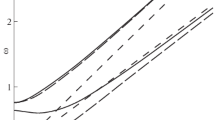Abstract
A self-consistent mathematical model is stated in linear and nonlinear formulations, which includes the equation of bending vibrations of a beam and the kinetic equation of damage accumulation in its material. The beam is assumed to be infinite. Such idealization is permissible if its boundaries are attached to optimal damping devices, i.e., the parameters of the boundary fixation are such that incident perturbations will not be reflected. This makes it possible to consider the beam model without taking into account the boundary conditions and regard vibrations propagating along the beam as traveling bending waves. As a result of analytical studies and numerical modeling, it is shown that material damage introduces frequency-dependent attenuation and significantly changes the character of the dispersion of the phase velocity of a bending elastic wave. In a classical Bernoulli–Euler beam, bending waves have one dispersive branch at any frequency, while, for a beam made of a damage-accumulating material, there are two pairs of dispersive branches in the entire frequency range, with one pair describing the wave propagation and the other, the wave attenuation. Within a geometrically nonlinear model of a damaged beam, the formation of intense bending waves of a stationary profile is studied. It is shown that such essentially nonsinusoidal waves can be both periodic and solitary (localized in space). Dependences have been determined relating the parameters of the waves (amplitude, width, and wave number) with the material damage. It was found that, with an increase in the material damage parameter, the amplitudes of the periodic and solitary waves as well as wave number of the periodic waves increase, while the width of the solitary wave decrease.








Similar content being viewed by others
REFERENCES
Kachanov, L.M., Introduction to Continuum Damage Mechanics, New York: Springer, 1986.
Rabotnov, Yu.N., Creep Problems in Structural Members, Amsterdam: North-Holland, 1969.
Maugin, G.A., The Thermomechanics of Plasticity and Fracture, Cambridge: Cambridge Univ. Press, 1992.
Collins, J.A., Failure of Materials in Mechanical Design: Analysis, Prediction, Prevention, 2nd ed., New York: Wiley, 1993.
Makhutov, N.A., Deformatsionnye kriterii razrusheniya i raschet elementov konstruktsii na prochnost' (Deformation Criteria of Fracture and Calculation of Construction Elements for Strength), Moscow: Mashinostroenie, 1981.
Bondar', V.S., Neuprugost’. Varianty teorii (Inelasticity. Theory Options), Moscow: Fizmatlit, 2004.
Volkov, I.A. and Korotkikh, Yu.G., Uravneniya sostoyaniya vyazkouprugoplasticheskikh sred s povrezhdeniyami (Equations of State of Viscoelastic-Plastic Media with Damage), Moscow: Fizmatlit, 2008.
Volkov, I.A. and Igumnov, L.A., Vvedenie v kontinual’nuyu mekhaniku povrezhdennoi sredy (Introduction to the Continuum Mechanics of a Damaged Medium), Moscow: Fizmatlit, 2017.
Lokoshchenko, A.M., Polzuchest’ i dlitel’naya prochnost' metallov (Creep and Durability of Metals), Moscow: Fizmatlit, 2016.
Nerazrushayushchiy kontrol’. Spravochnik, T. 3. Ul’trazvukovoi kontrol’ (Nondestructive Testing, Handbook, Vol. 3: Ultrasound Testing), Klyuev, V.V., Ed., Moscow: Mashinostroenie, 2004.
Uglov, A.L., Erofeev, V.I., and Smirnov, A.N., Akusticheskii kontrol’ oborudovaniya pri izgotovlenii i ekspluatatsii (Acoustic Control of Equipment during its Manufacture and Operation), Moscow: Nauka, 2009.
Erofeev, V.I. and Nikitina, E.A., The self-consistent dynamic problem of estimating the damage of a material by an acoustic method, Acoust. Phys., 2010, vol. 56, no. 4, pp. 584–587. https://doi.org/10.1134/S106377101004024X
Erofeev, V.I. and Nikitina, E.A., Localization of a strain wave propagating in damaged material, J. Mach. Manuf. Reliab., 2010, vol. 39, pp. 559–561. https://doi.org/10.3103/S1052618810060087
Erofeev, V.I., Nikitina, E.A., and Sharabanova, A.V., Wave propagation in damaged materials using a new generalized continuum, in Mechanics of Generalized Continua. One Hundred Years after the Cosserats, Maugin, G.A. and Metrikine, A.V., Eds., Berlin: Springer, 2010, pp. 143–148. https://doi.org/10.1007/978-1-4419-5695-8_15
Erofeev, V.I., Nikitina, E.A., and Smirnov, S.I., Acoustoelasticity of damaged materials, Kontrol’. Diagn., 2012, no. 3, pp. 24–26.
Stulov, A. and Erofeev, V., Frequency-dependent attenuation and phase velocity dispersion of an acoustic wave propagating in the media with damages, in Generalized Continua as Models for Classical and Advanced Materials, Altenbach, H. and Forest, S., Eds., Berlin: Springer, 2016, pp. 413–423. https://doi.org/10.1007/978-3-319-31721-2_19
Dar’enkov, A.B., Plekhov, A.S., and Erofeev, V.I., Effect of material damage on parameters of a torsional wave propagated in a deformed rotor, Proc. Eng., 2016, vol. 150, pp. 86–90. https://doi.org/10.1016/j.proeng.2016.06.722
Erofeev, V.I. and Lisenkova, E.E., Excitation of waves by a load moving along a damaged one-dimensional guide lying on an elastic foundation, J. Mach. Manuf. Reliab., 2016, vol. 45, pp. 495–499. https://doi.org/10.3103/S1052618816060054
Erofeev, V.I., Leonteva, A.V., and Malkhanov, A.O., Influence of material damage on propagation of a longitudinal magnetoelastic wave in a rod, Vychisl. Mekh. Splosh. Sred, 2018, vol. 11, no. 4, pp. 397–408. https://doi.org/10.7242/1999-6691/2018.11.4.30
Antonov, A.M., Erofeev, V.I., and Leonteva, A.V., Influence of material damage on Rayleigh wave propagation along half-space boundary, Vychisl. Mekh. Splosh. Sred, 2019, vol. 12, no. 3, pp. 293–300. https://doi.org/10.7242/1999-6691/2019.12.3.25
Brikkel, D.M., Erofeev, V.I., and Nikitina, E.A., Influence of material damage on the parameters of a nonlinear longitudinal wave which spread in a rod, IOP Conf. Ser.: Mater. Sci. Eng., 2020, vol. 747, p. 012053. https://doi.org/10.1088/1757-899X/747/1/012048
Vibratsii v tekhnike: spravochnik. T. 1. Kolebaniya lineinykh sistem (Vibrations in the Technics, Handbook, Vol. 1: Oscillations of Linear Systems), Bolotin, V.V., Ed., Moscow: Mashinostroenie, 1978.
Vesnitskii, A.I., Izbrannye trudy po mekhanike (Selected Works on Mechanics), Nizh. Novgorod: Nash Dom, 2010.
Moiseev, N.N., Asimptoticheskie metody nelineinoi mekhaniki (Asymptotic Methods of Nonlinear Mechanics), Moscow: Nauka, 1981.
Funding
The work was carried out within the Russian state task for fundamental scientific research for 2021-2023 (the topic no. 0030-2021-0025).
Author information
Authors and Affiliations
Corresponding author
Additional information
Translated by E. Chernokozhin
Rights and permissions
About this article
Cite this article
Brikkel, D.M., Erofeev, V.I. & Leonteva, A.V. Propagation of Bending Waves in a Beam the Material of Which Accumulates Damage During Its Operation. J Appl Mech Tech Phy 62, 1097–1105 (2021). https://doi.org/10.1134/S002189442107004X
Received:
Revised:
Accepted:
Published:
Issue Date:
DOI: https://doi.org/10.1134/S002189442107004X




